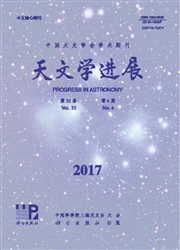

 中文摘要:
中文摘要:
行星状星云是研究恒星演化、星际介质与星系化学形成历史与演化等问题的重要探针.距离是行星状星云的基本物理参数,对研究其大小、光度、电离质量、形成率、空间密度和在银河系内的分布等性质至关重要.河内行星状星云距离的研究已有几十年历史,但其测距结果的准确性普遍偏低,仅有31 颗距离的不确定度在20% 内.概述了行星状星云测距的9 种主要方法,即:三角视差法、星团成员法、膨胀视差法、分光视差法、红化方法、Na D 线吸收法、中心重力法、统计方法、运动学方法.着重介绍运动学测距法,用于测量受银道面上消光严重或没有可观测中心星但射电较明亮的行星状星云距离,为将来进一步的测距工作提供参考.
 英文摘要:
英文摘要:
Planetary Nebula is an important tracer of Galactic chemical history and evo-lution, star and interstellar evolution. Distance as a basic physical parameter of planetary nebula, is crucial to study its size, luminosity, ionized mass, formation rate, space density and Galactic distribution. Distance of planetary nebula has been studied for several decades, but most of their distances are not well determined, e.g. only thirty-one planetary nebulae have distance measurement with uncertainty within 20%. We summarize ma jor distance measurement methods of planetary nebulae, i.e., trigonometric parallax, cluster member, expansion parallax, spectroscopic parallax, reddening, Na D absorption, determinations of central star gravities, Shklovsky method, kinematics method, and then discuss the limita-tions and applications scope of each method in detail. Actually, applying different methods to the same planetary nebulae can have a huge difference in distance, and even the same method can lead to great difference for the same planetary nebula. We focus on the kine-matics method applied to planetary nebulae either seriously effected by Galactic extinction or having no observable centra star but being radio bright. The kinematics distance has been used in our on-going project of radio planetary nebulae distance measurement.
 同期刊论文项目
同期刊论文项目
 同项目期刊论文
同项目期刊论文
 期刊信息
期刊信息
